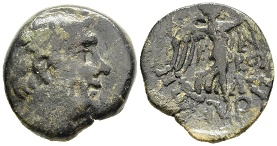Fine Coins Showcase
Antiquities Showcase
Show Empty Categories
Shop Search
Shopping Cart
My FORVM
Contact Us
About Forum
Shopping at Forum
Our Guarantee
Payment Options
Shipping Options & Fees
Privacy & Security
Forum Staff
Selling Your Coins
Identifying Your Coin
FAQs
zoom.asp
Home ▸ Catalog ▸ |View Options:   | | | | | | |


Soli, a Rhodian colony, was founded, c. 700 B.C. The word solecism (a grammatical blunder) is derived from Soli; Athenians considered the Soli dialect to be corrupted Attic Greek. Pompey the Great destroyed Soli and refounded the site as Pompeiopolis, c. 66 B.C. Realizing they were driven to crime by desperation, Pompey spared and resettled numerous captured Cilician pirates at Pompeiopolis.RP112764. Bronze AE 20, cf. SNG BnF 1213 ff., SNG Levante 880 ff., BMC Lycaonia 54, SNG Cop 246, SNGvA 5887, RPC Online I -, weight 5.359 g, maximum diameter 19.5 mm, die axis 0o, Cilicia, Soli-Pompeiopolis (near Mersin, Turkey) mint, probably struck 66 - 48 B.C.; obverse head of Pompey right; reverse ΠOMΠHIOΠOΛEITΩN, Nike advancing right, wreath in right hand, palm over shoulder in left, monograms upper right; rare; SOLD
France, Provincial, Duchy of Normandy William the Conqueror, 1035 - 1087


Similar reverses are sometimes described as a two-towered cathedral facade, however, the evolution of the type suggests something different. Richard I (942 - 996) struck a denier at Rouen with a temple reverse, imitative of a type struck by Louis the Pius, son of Charlemagne. Only a few years later, by the turn of the millennium, the temple had degenerated into a variety of nearly unrecognizable abstract patterns. That the image on this specimen may resemble a two-towered cathedral is likely only coincidental. More than 20 different abstract "temple" types are known. A tag received with this coin identifies it as struck by William I the Conqueror, cf. Legros 312. Legros is an unpublished dissertation and we have never been able to find a copy. Roberts' attributes this type to Henry I, 1106 - 1135. Dumas attributes it to William I the Conqueror. The weight of this coin does suggest it was struck under William, during whose rule, according to Dumas, the weight of the denier dropped below 0.8g.ME113214. Silver denier, cf. Dumas pl. XX, 1 - 2; Poey d'Avant 138, pl. V, 3; Roberts 4833, aVF, dark toning, weight 0.776 g, maximum diameter 19.6 mm, Rouen mint, c. 1070 - 1087; obverse NORMAN DVX, short cross pattée, pellet in each angle, within linear inner border, blundered imitation of a legend around; reverse crude abstract temple, center pellet between triangular pediment peak, pellet on each side of temple, annulets on lower outer left and right edges of building, pellet below, cross at the bottom; rare; SOLD
France, Duchy of Normandy, Robert Curthose (Robert II), 1087 - 1106


Robert Curthose (Robert II) was the Duke of Normandy from 1087 until 1106. Robert, the eldest son of William the Conqueror and Matilda of Flanders. His discord with his brothers began with a prank played by his younger brothers William Rufus and Henry, who dumped a full chamber-pot over his head, and ended when Henry invaded Normandy and imprisoned him for the rest of his life.ME113215. Billon denier, Dumas pl. XX 14, Legros 372 (unverified, not held), Roberts -, F, dark toning, weight 0.463 g, maximum diameter 18.7 mm, Rouen mint, obverse crude abstract temple, two annulets lower field; reverse NORMAN DVX, cross pattée, pellet in each quarter; rare; SOLD
Hadrian, 11 August 117 - 10 July 138 A.D., Delphi, Phokis


Delphi is a town on Mount Parnassus in the south of mainland Greece. It's the site of the 4th-century-B.C. Temple of Apollo, once home to a legendary oracle. This extensive mountainside archaeological complex contains the remains of the sanctuaries of Apollo and Athena Pronaia, as well as an ancient stadium and theater. Delphi Archaeological Museum displays artifacts found among the ruins.RP111645. Bronze AE 21, RPC III 429.6 (this coin, 7 spec.); BCD Lokris 394 (this coin); Svoronos p. 36, 55, pl. XXVII, 13; BMC Central p. 28, 25 pl. IV, 16; SNG Cop 156, VF, nice green patina, light roughness, weight 5.289 g, maximum diameter 20.8 mm, die axis 0o, Delphi (Greece) mint, 11 Aug 117 - 10 Jul 138 A.D.; obverse AY KAI TPAIANOC AΔPIANOC AYΓ (Imperator Caesar Traianus Hadrianus Augustus), laureate bust of Hadrian right, bare chest (heroic bust), aegis on left shoulder; reverse ΔEΛΦΩN, Apollo Citharoedus standing right, wearing long chiton and long chlamys, playing Kithara (lyre); ex Numismatica Ars Classica auction 55 (8 Oct 2010), lot 394 (price realized 1,500 CHF, plus fees); ex BCD Collection ; rare; SOLD



Page created in 1.266 seconds.






